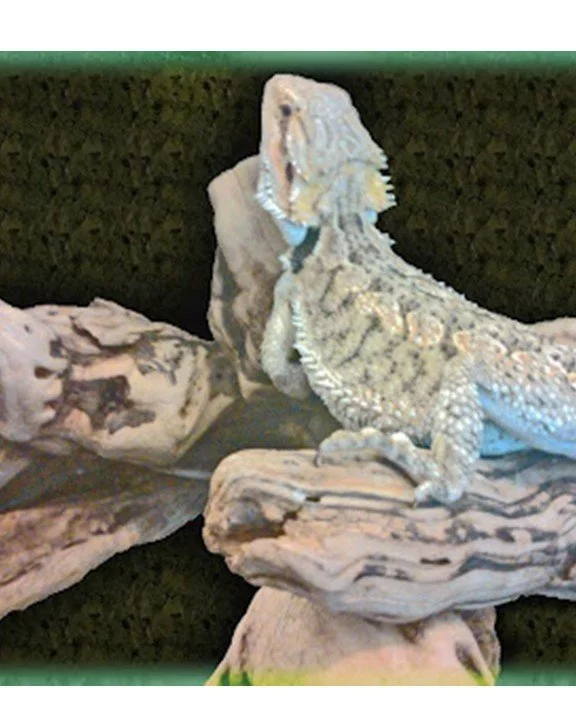
Inland Bearded Dragon
SOP Care Sheet
Enclosure
The Inland Bearded Dragon is a moderately sized lizard, however they need a large enclosure. In our classroom we use a Neodesha enclosure which is about a 36" inch (91.44 cm) enclosure. In our cage we use newspaper for substrate, however Jurassic Sand can be substituted if they are over 6 inches long (you do not want them to become impacted). Inland Bearded Dragons are semi-arboreal (they like to climb), so they need at least one climbing surface. In our enclosure we have two climbing surfaces, low resting bowls for food and water and a Tupperware container that is filled halfway with coconut husk. The Tupperware container is used as a humidore box, and has a hole cut in the side because this lizard prefers entrance from the side rather than the top. The humidore box assists with humidity, and must be kept moist. One can use pesticide free branches and rocks for climbing materials.
Daily Care
Replace soiled newspaper, provide fresh water, remove old food, and moisten humidor box daily.
Lighting and Temperature
Bearded Dragons are diurnal lizards, therefore they require a UVB bulb. We also provide a large sized heat pad under the cage. Make sure the heat pad is placed under the same side as the light. We use Zoo Med ReptiTherm® Under Tank Heater, Large. We place the light on a timer. The timer is set for a 12/12 light cycle.
We use an infrared thermal heat gun to check the temperature of our cage regularly. We try to make the "heat" side of his cage around 100 degrees F (37.77 degrees C). The "cooler" side of the cage is kept around 70 degrees F (21.11 degrees C).
SOP Feed Schedule
We feed our bearded dragon Monday, Wednesday, Thursday and Friday only.
Monday- Defrost carrots, corn, and peas and place in bowl. Add Kale or Romaine lettuce to the mixture and mix contents of the bowl so he/she can't pick out their favorites. Add a small amount of apple pieces to the bowl and mix in. Add 10-15 large crickets to the cage, crickets should be dusted in either calcium powder or vitamin mix. Alternate between calcium and mineral mix each feeding. For example, if you feed calcium sprinkled crickets on Monday, then on Wednesday use the mineral mix. Crickets do not need to be handfed, and before adding crickets to cage, count the remaining crickets and add the difference.
Wednesday-Defrost carrots, corn, and peas and place in bowl. Add Kale or Romaine lettuce to the mixture and mix contents of the bowl so he/she can't pick out their favorites. Add a small amount of apple pieces to the bowl and mix in. Add 10-15 large crickets to the cage, crickets should be dusted in either calcium powder or mineral mix. Alternate between calcium and mineral mix each feeding. Crickets do not need to be handfed, and before adding crickets to cage, count the remaining crickets and add the difference.Thursday- Add 10-15 large crickets to the cage, crickets should be dusted in either calcium powder or mineral mix. Alternate between calcium and mineral mix each feeding.
Friday- Defrost carrots, corn, and peas and place in bowl. Add Kale or Romaine lettuce to the mixture and mix contents of the bowl so he/she can't pick out their favorites. Add a small amount of apple pieces to the bowl and mix in. Add 5-6 mealworms to the top of the mixture.
DO NOT EVER feed spinach or lightening bugs to dragons. This will kill them.
They can be fed turnip greens, collards, kale, mustard greens, romaine, endive, escarole, dandelion, green beans, squash, peas, sweet potato, cilantro, red bell peppers, and in small amounts; grapes, raspberries, blueberries, or cantaloupe. Fix a small bowl of fruits/veggies daily for them to chow on.Also waxworms can be fed as a treat. When we have them, we feed our bearded dragon five waxworms every day.
Can occasionally have waxworms, phoenix worms or mealworms. Pick one of the three and can have once a week if available.



